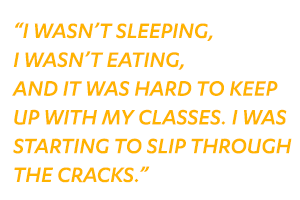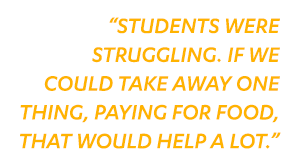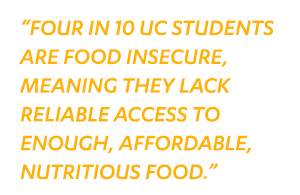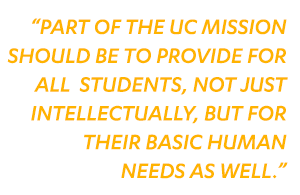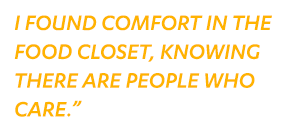 |
||||||
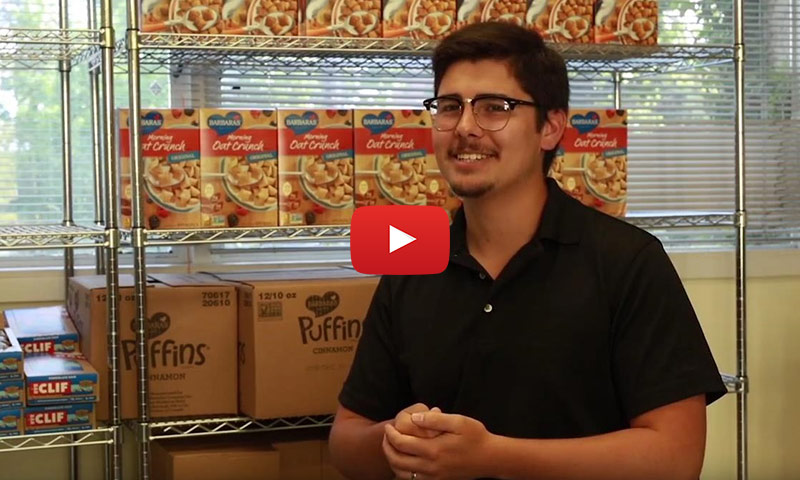 Video Credit: Produced by UCLA students as part of the UC Global Food
Video Credit: Produced by UCLA students as part of the UC Global Food Initiative and UCLA’s Healthy Campus Initiative |
||||||
The UCLA Food Closet is housed in a small former closet space on the first floor of the Student Activities Center. Tucked next to a staircase in a back hall, a student worker stocks the shelves while more students wait outside the door to grab a bag of oatmeal, a piece of fruit or a pull-top can of soup. Run by staff and students from the Community Programs Office (CPO), food is available to any student who needs it: some want a quick snack between classes, or need help finding a few meals between paychecks, while others are struggling without a safety net and rely on the resource daily. Students can remain anonymous, there’s no sign-in or tracking system. About 1 ½ tons of snacks, fresh fruits, vegetables and ingredients for meals are distributed every week. As an undergraduate, Nicole Ngaosi ’14 found herself too busy to eat. Between her studies, work, student organizing and volunteer commitments, time was tight and she didn’t have much money, so eating became an afterthought. She felt privileged to be able to attend college, and guilty about asking her parents, who had other dependents to care for, for food or money. She says, “I wasn’t sleeping, I wasn’t eating, and it was hard to keep up with my classes. I was starting to slip through the cracks.” Ngaosi is now a full-time graduate student pursuing a Master’s degree in Asian-American studies and social welfare. She works on-campus as a food security coordinator. She says, “The Food Closet helped me get through the day. It ended up being one of the reasons I was able to graduate.” The UCLA Food Closet got its start when civil engineering major Abdallah Jadallah ’11, then president of the Muslim Students Association, realized his peers were spending a lot of time thinking about access to cheap food. He and his friends would fill up on dollar tacos, or head over to eat leftovers from a campus event that would otherwise be discarded. He realized these cheap, often unhealthy choices were often the main source of nutrition for many students. Jadallah, now a risk consultant, says, “Students get to college and expenses are high, rent is high, dorms are high, food costs are high, everything is high.”
He talked to Antonio Sandoval ’02, M.A. ’07, director of UCLA’s Community Programs Office, about what he was seeing. Located in the Student Activities Center, The CPO is home to student-initiated and student-run projects that focus on community service, access and retention to UCLA for historically underserved and underrepresented students. Originally a multicultural center with largely students of color, CPO has evolved to serve all students. Many students come for the many services they provide, mostly free of charge. Working together, Jadallah and Sandoval came up with a plan to establish the Food Closet. Jadallah says, “Students were struggling. If we could take away one thing, paying for food, that would help a lot.” They located a closet to use as a pantry space, found a slightly-used refrigerator, and got to work filling them with food. At first donations mainly came from CPO staff and unsolicited grants, over time Sandoval began cultivating relationships with campus partners, alumni and donors who kept the closet stocked.
“The Student Food Access and Security Study,” a survey of 9,000 students published in 2016, found that four in 10 UC students are food insecure, meaning they lack reliable access to enough, affordable, nutritious food. While some students experience short periods of food insecurity, or skip meals to save money, others have no safety net at all. Among the general population this number is closer to 13 percent. Lack of food can lead to less energy and ability to focus, engage, learn and grow. For students, this can lead to poor grades, poor health and may compromise their future success. Among UC students, college is a time of increased food insecurity. At a rigorous university like UCLA, students are striving to do their best work every day. Sandoval says, “Food shouldn’t be the reason you don’t perform academically well. We would like to make sure that every student who enrolls here graduates. If that means providing innovative programs, then we have to respond.” The mark of UCLA’s success is the student retention rate; analysis of the CPO Food Closet program reveals that the program is worth the price.
In 2010, the LA Times published an article about the Food Closet, one of the first of its kind on a college campus. This led to a wave of national media coverage and the implementation of similar programs in at least 50 colleges across the country. Jadallah says his experience with the Food Closet changed him, “UCLA is an environment full of innovators who want to be leaders and serve the community. UCLA administrators are willing to work with students and support their ideas. I went in not knowing about life, and came out a better person ready for the world.” Suzy Howell ’75, a UCLA volunteer coordinator at the time who now works for UCLA Alumni Affairs, remembers reading the 2010 LA Times article. She started spreading awareness and encouraging donations from friends and family. Her dentist, a Bruin, donates boxes of toothbrushes and toothpaste. Howell currently represents the UCLA Alumni Association on the Food Security Work Group. She says, “I have seen what these students have overcome to get to UCLA, they have earned their place. Going hungry, sitting in class not being able to concentrate, listening to your stomach growl, that is just wrong.”
In 2014 UC President Janet Napolitano launched the UC Global Food Initiative (GFI) to tackle the problem of feeding the world’s increasing population. One area of the initiative was to improve student access to healthy food on campus. Each campus received $75,000 and set-up Food Security Work Groups to allocate the grant, bringing together students, administrators, staff, faculty and community members. Groups also came together to share best practices at the UC level. UCLA’s Work Group created partnerships with existing food security and access programs like UCLA’s vanguard Healthy Campus Initiative, the Westside Food Bank, the Wesley Foundation’s 580 Cafe, ECRT Meal Vouchers, CalFresh, Food for Finals and UCLA’s innovative Swipe Out Hunger program where students donate unused meal plan credits to other students in need. Tyler Watson, M.P.H. ’13 is pursuing his Ph.D. at UCLA, studying and implementing strategies to address access to food. He helped implement the Farmer’s Market Gleaning program, which collects organic produce for the Food Closet. Watson serves as a campus representative to GFI, and is a graduate student researcher for the project, leading focus groups and conducting research about food security efforts and results. He believes the struggles students experience while in college can be alleviated by long-lasting actions from UC, and higher education in general. He says, “As a leading public institution, UCLA can address this issue. Part of the UC mission should be to provide for all students, not just intellectually, but for their basic human needs as well. These struggles undermine their relationship with the institution. It’s a critical issue to address, and it’s possible.” Meeting basic needs allows students to achieve their full potential at school and in the community when they leave UCLA. In May of 2015, UCLA students voted to approve a social justice ballot measure ensuring a permanent contribution of 50 cents per student, per quarter, to the Food Closet, about $50,000 dollars/year. The plan is to use this money for perishable items like milk, eggs and lunchmeat to stock the Food Closet. The UCLA Parent and Family Council made a commitment to help provide resources for students through a partnership with the Food Closet. Alexandra Brown, senior director Parent and Family Programs says, “Donating to the Food Closet is a tangible way for parents to contribute to campus. Once parents learn of the need they want to get involved and make a difference.” The group donated nearly $14,000 last fiscal year, tailoring their donations to deliver items that are always in demand: personal hygiene items, soap, shampoo, as well as food. In 2016, Napolitano allotted an additional $151,000 per year, for two years, to extend support for ongoing projects and to look into the social and financial barriers that impact student access to food. For the UCLA Food Security Work Group this also was a chance to do some strategic planning to sustain their efforts, and set future goals. There are plans to build a second Food Closet on South Campus, to teach cost-cutting shopping and budgeting skills, and start a mobile kitchen for healthy cooking and eating demonstrations. Sandoval thinks the last 10 years have been a time of change at UCLA. He says, “I think there’s been an effort to look at student life from a different point of view and create services to meet students’ needs. Campus is filled with people going out of their way to help.” There are plans to organize gift boxes for Thanksgiving dinner, and possibly for winter break, when students face extra financial demands.
Jose Ocampo started saving for college in high school. An undergraduate, commuter student he found that coming from a low-income family, even with financial aid, costs added up quickly. He says, “For some of us just being in college is a dream, it’s hard to think about giving it up because it’s too expensive. If you can make it off one meal a day, that’s a sacrifice we make to try to graduate.” His family hit a rough time, and he started working almost full-time while going to school to help make ends meet. Already stretched thin, his grades slipped and he was dismissed from school. Now re-enrolled at UCLA, Ocampo manages logistics and donations for the Food Closet as a food security coordinator. He is proud that students have a voice in the decision-making process, appreciates the work that has been done, and wants to help the program continue to grow and help more students in need. He says, “Sometimes the easiest thing to cut is food. It’s a tough position to be in, to have to think that way. I found comfort in the Food Closet, knowing there are people who care.” Howell sums up the feelings of many who work, donate and volunteer to make the Food Closet possible, “Let’s let them be students, this is the time in their lives when they should be focused on their academics, and preparing to go out and be agents of change for our society. They can’t do that until we meet their basic needs.” For alumni and others who are interested in getting involved, there are many ways to help.  to the Food Closet |
||||||
|
|

